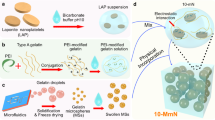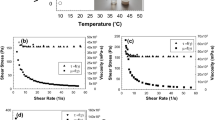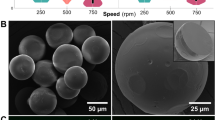Abstract
Cell-based regenerative therapies for bone defects usually employ bone precursor cells seeded on solid scaffolds. Thermosensitive hydrogels that harden at body core temperature are promising alternative cell carriers as they are applicable minimally invasively. We modified Pluronic® P123 with different chain extenders and assessed rheology and biocompatibility of the resulting hydrogels. The best candidate was tested in a rat’s femoral defect model. All gels hardened above 25 °C with butane-diisocyanate-hydrogels (BDI-gels) displaying the highest storage moduli. BDI-gels showed the most favourable biocompatibility and did not affect cellular adipogenic or osteogenic differentiation in vitro. Implantation of BDI-hydrogel into femoral defects did not impede bone healing in vivo as evidenced by μCT and histological analysis. We conclude that thermosensitive BDI-gels are promising alternative cell carriers. The gels harden upon injection in vivo without interfering with bone metabolism. Further experiments will assess the gels’ capacity to effectively transport living cells into bone defects.









Similar content being viewed by others
References
AI Caplan. Adult mesenchymal stem cells for tissue engineering versus regenerative medicine. J Cell Physiol. 2001;213(2):341–7.
Morrison SJ, Shah NM, Anderson DJ. Regulatory mechanisms in stem cell biology. Cell. 1997;88(3):287–98.
Pittenger MF, Mackay AM, Beck SC, Jaiswal RK, Douglas R, Mosca JD, et al. Multilineage potential of adult human mesenchymal stem cells. Science. 1999;284(5411):143–7.
Zuk PA, Zhu M, Mizuno H, Huang J, Futrell JW, Katz AJ, et al. Multilineage cells from adipose tissue: implications for cell-based therapies. Tissue Eng. 2001;7(2):211–28.
Docheva D, Popov C, Mutschler W, Schieker M. Human mesenchymal stem cells in contact with their environment: surface characteristics and the integrin system. J Cell Mol Med. 2001;11(1):21–38.
Kassam M. Stem cells: potential therapy for age-related diseases. Ann N Y Acad Sci. 2006;1067:436–42.
Liechty KW, MacKenzie TC, Shaaban AF, Radu A, Moseley AM, Deans R, et al. Human mesenchymal stem cells engraft and demonstrate site-specific differentiation after in utero transplantation in sheep. Nat Med. 2000;6(11):1282–6.
Schieker M, Seitz S, Gulkan H, Nentwich M, Horvath G, Regauer M, et al. Tissue engineering of bone. Integration and migration of human mesenchymal stem cells in colonized constructs in a murine model. Orthopade. 2004;33(12):1354–60.
Giannoudis PV, Einhorn TA, Marsh D. Fracture healing: the diamond concept. Injury. 2007;38(Suppl 4):S3–6.
Drosse I, Volkmer E, Capanna R, De Biase P, Mutschler W, Schieker M. Tissue engineering for bone defect healing: an update on a multi-component approach. Injury. 2008;39(Suppl2):S9–20.
Schieker M, Heiss C, Mutschler W. Bone substitutes. Unfallchirurg. 2008;111(8):613-19; quiz 20.
Vacanti CA. History of tissue engineering and a glimpse into its future. Tissue Eng. 2006;12(5):1137–42.
Lee KY, Mooney DJ. Hydrogels for tissue engineering. Chem Rev. 2001;101(7):1869–79.
Fedorovich NE, Alblas J, de Wijn JR, Hennink WE, Verbout AJ, Dhert WJ. Hydrogels as extracellular matrices for skeletal tissue engineering: state-of-the-art and novel application in organ printing. Tissue Eng. 2007;13(8):1905–25.
Cohn D, Sosnik A, inventors; Responsive biomedical composites. 2005.
Park D, Wu W, Wang Y. A functionalizable reverse thermal gel based on a polyurethane/PEG block copolymer. Biomaterials. 2011;32(3):777–86.
Nguyen MK, Lee DS. Injectable biodegradable hydrogels. Macromol Biosci. 2010;10(6):563–79.
Liao HT, Chen CT, Chen JP. Osteogenic differentiation and ectopic bone formation of canine bone marrow-derived mesenchymal stem cells in injectable thermo-responsive polymer hydrogel. Tissue Eng Part C Methods. 2011;17(11):1139–49.
Cohn D, Lando G, Sosnik A, Garty S, Levi A. PEO–PPO–PEO-based poly(ether ester urethane)s as degradable reverse thermo-responsive multiblock copolymers. Biomaterials. 2006;27(9):1718–27.
Alexandridis P, Holzwarth JF, Hatton TA. Micellization of poly(ethylene oxide)-poly(propylene oxide)-poly(ethylene oxide) triblock copolymers in aqueous solutions: thermodynamics of copolymer association. Macromolecules. 1994;27(9):2414–25.
Boker W, Yin Z, Drosse I, Haasters F, Rossmann O, Wierer M, et al. Introducing a single-cell-derived human mesenchymal stem cell line expressing hTERT after lentiviral gene transfer. J Cell Mol Med. 2008;12(4):1347–59.
Haasters F, Prall WC, Anz D, Bourquin C, Pautke C, Endres S, et al. Morphological and immunocytochemical characteristics indicate the yield of early progenitors and represent a quality control for human mesenchymal stem cell culturing. J Anat. 2009;214(5):759–67.
Polzer H, Volkmer E, Saller MM, Prall WC, Haasters F, Drosse I, et al. Long-term detection of fluorescently labeled human mesenchymal stem cell in vitro and in vivo by semi-automated microscopy. Tissue Eng Part C Methods. 2012;18(2):156–65.
Cespi M, Bonacucina G, Casettari L, Mencarelli G, Palmieri GF. Poloxamer thermogel systems as medium for crystallization. Pharm Res. 2012;29(3):818–26.
Antunes FE, Gentile L, Rossi CO, Tavano L, Ranieri GA. Gels of pluronic F127 and nonionic surfactants from rheological characterization to controller drug permeation. Colloid Surf B Interfaces. 2011;87(1):42–8.
Song MJ, Lee DS, Ahn JH, Kim DJ, Kimi SC. Dielectric behaviour during sol–gel transition of PEO–PPO–PEO triblock copolymers aqueous solution. Polym Bull. 2000;43:497–504.
Schwaz C, Leicht U, Drosse I, Ulrich V, Luibl V, Schieker M, et al. Characterization of adipose-derived equine and canine mesenchymal stem cells after incubation in agarose-hydrogel. Vet Res Commun. 2011;35(8):487–99.
Watanabe J, Kashii M, Hirao M, Oka K, Sugamoto K, Yoshikawa H, et al. Quick-forming hydroxyapatite/agarose gel composites induce bone regeneration. J Biomed Mater Res A. 2007;83(3):845–52.
Sakai S, Hashimoto I, Kawakami K. Synthesis of an agarose-gelatin conjugate for use as a tissue engineering scaffold. J Biosci Bioeng. 2007;103(1):22–6.
Nuss KM, Auer JA, Boos A, von Rechenberg B. An animal model in sheep for biocompatibility testing of biomaterials in cancellous bones. BMC Musculoskelet Disord. 2006;7:67.
Acknowledgments
This work was supported by a research Grant from the Bavarian Research Foundation (Bavarian Research Cooperation ForZebRA-cell-based regeneration for the musculoskeletal system in old age (www.forzebra.de)). The authors thank Johanna Lindermayer and Claudia Harbauer for technical assistance. This study is part of the doctoral thesis of Uta Leicht and published with permission of Ludwig-Maximilians-University, Munich.
Author information
Authors and Affiliations
Corresponding author
Additional information
Elias Volkmer and Uta Leicht have contributed equally to this study.
Rights and permissions
About this article
Cite this article
Volkmer, E., Leicht, U., Moritz, M. et al. Poloxamer-based hydrogels hardening at body core temperature as carriers for cell based therapies: in vitro and in vivo analysis. J Mater Sci: Mater Med 24, 2223–2234 (2013). https://doi.org/10.1007/s10856-013-4966-6
Received:
Accepted:
Published:
Issue Date:
DOI: https://doi.org/10.1007/s10856-013-4966-6




